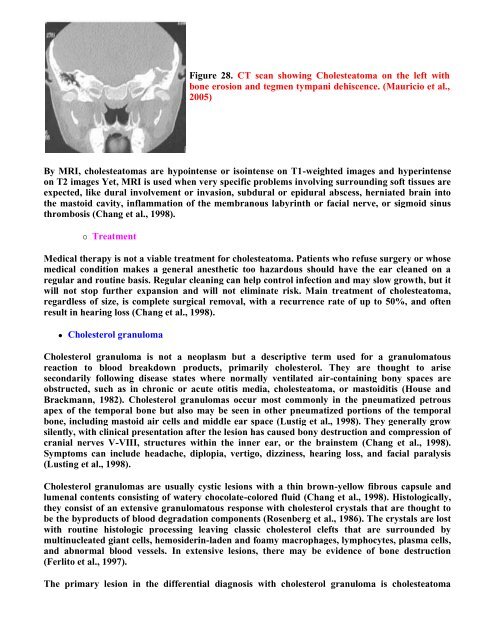INTRODUCTION Granulomatous inflammation is a distinctive ...
INTRODUCTION Granulomatous inflammation is a distinctive ...
INTRODUCTION Granulomatous inflammation is a distinctive ...
You also want an ePaper? Increase the reach of your titles
YUMPU automatically turns print PDFs into web optimized ePapers that Google loves.
By MRI, cholesteatomas are hypointense or <strong>is</strong>ointense on T1-weighted images and hyperintense<br />
on T2 images Yet, MRI <strong>is</strong> used when very specific problems involving surrounding soft t<strong>is</strong>sues are<br />
expected, like dural involvement or invasion, subdural or epidural abscess, herniated brain into<br />
the mastoid cavity, <strong>inflammation</strong> of the membranous labyrinth or facial nerve, or sigmoid sinus<br />
thrombos<strong>is</strong> (Chang et al., 1998).<br />
Treatment<br />
Medical therapy <strong>is</strong> not a viable treatment for cholesteatoma. Patients who refuse surgery or whose<br />
medical condition makes a general anesthetic too hazardous should have the ear cleaned on a<br />
regular and routine bas<strong>is</strong>. Regular cleaning can help control infection and may slow growth, but it<br />
will not stop further expansion and will not eliminate r<strong>is</strong>k. Main treatment of cholesteatoma,<br />
regardless of size, <strong>is</strong> complete surgical removal, with a recurrence rate of up to 50%, and often<br />
result in hearing loss (Chang et al., 1998).<br />
Cholesterol granuloma<br />
Figure 28. CT scan showing Cholesteatoma on the left with<br />
bone erosion and tegmen tympani deh<strong>is</strong>cence. (Mauricio et al.,<br />
2005)<br />
Cholesterol granuloma <strong>is</strong> not a neoplasm but a descriptive term used for a granulomatous<br />
reaction to blood breakdown products, primarily cholesterol. They are thought to ar<strong>is</strong>e<br />
secondarily following d<strong>is</strong>ease states where normally ventilated air-containing bony spaces are<br />
obstructed, such as in chronic or acute otit<strong>is</strong> media, cholesteatoma, or mastoidit<strong>is</strong> (House and<br />
Brackmann, 1982). Cholesterol granulomas occur most commonly in the pneumatized petrous<br />
apex of the temporal bone but also may be seen in other pneumatized portions of the temporal<br />
bone, including mastoid air cells and middle ear space (Lustig et al., 1998). They generally grow<br />
silently, with clinical presentation after the lesion has caused bony destruction and compression of<br />
cranial nerves V-VIII, structures within the inner ear, or the brainstem (Chang et al., 1998).<br />
Symptoms can include headache, diplopia, vertigo, dizziness, hearing loss, and facial paralys<strong>is</strong><br />
(Lusting et al., 1998).<br />
Cholesterol granulomas are usually cystic lesions with a thin brown-yellow fibrous capsule and<br />
lumenal contents cons<strong>is</strong>ting of watery chocolate-colored fluid (Chang et al., 1998). H<strong>is</strong>tologically,<br />
they cons<strong>is</strong>t of an extensive granulomatous response with cholesterol crystals that are thought to<br />
be the byproducts of blood degradation components (Rosenberg et al., 1986). The crystals are lost<br />
with routine h<strong>is</strong>tologic processing leaving classic cholesterol clefts that are surrounded by<br />
multinucleated giant cells, hemosiderin-laden and foamy macrophages, lymphocytes, plasma cells,<br />
and abnormal blood vessels. In extensive lesions, there may be evidence of bone destruction<br />
(Ferlito et al., 1997).<br />
The primary lesion in the differential diagnos<strong>is</strong> with cholesterol granuloma <strong>is</strong> cholesteatoma


